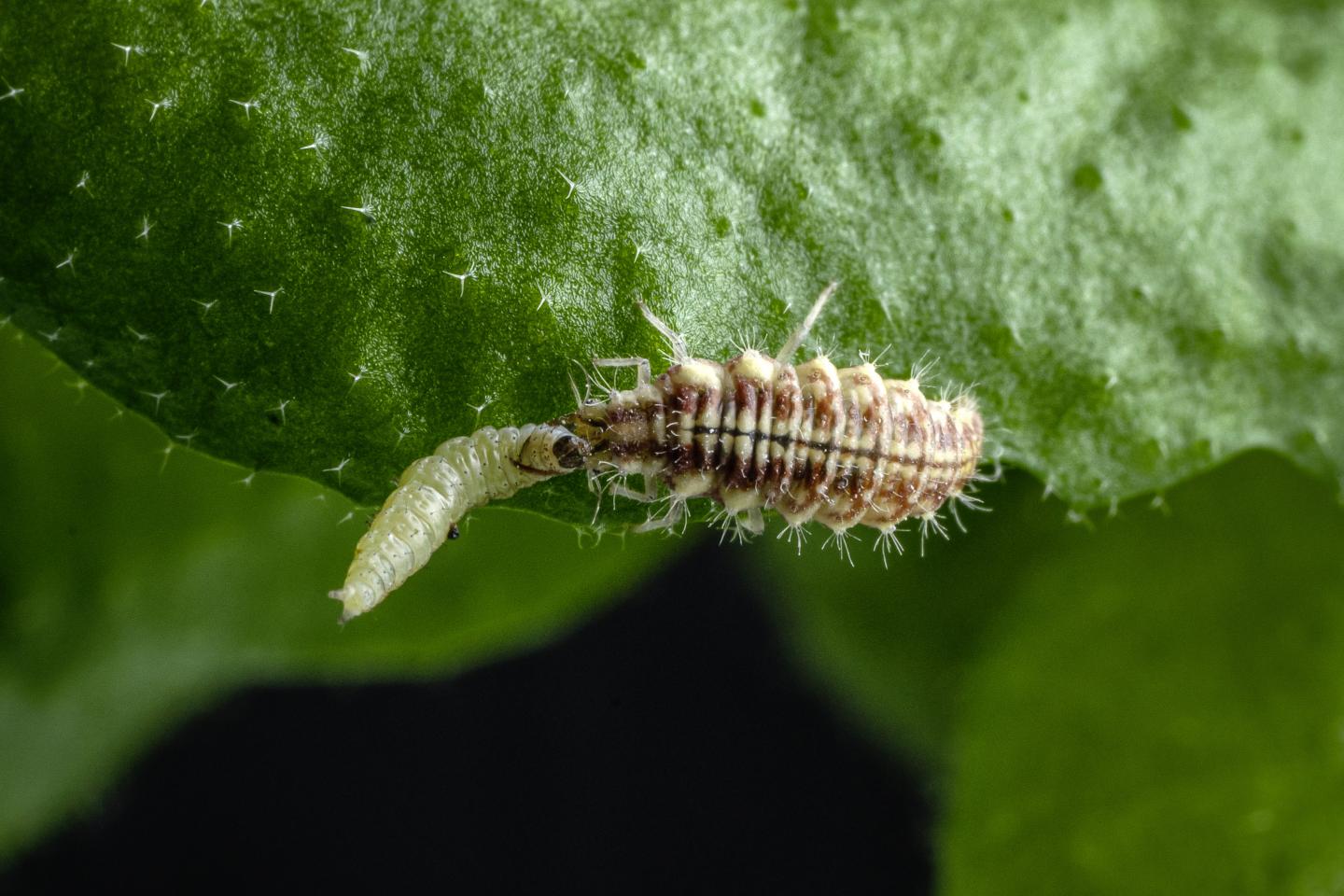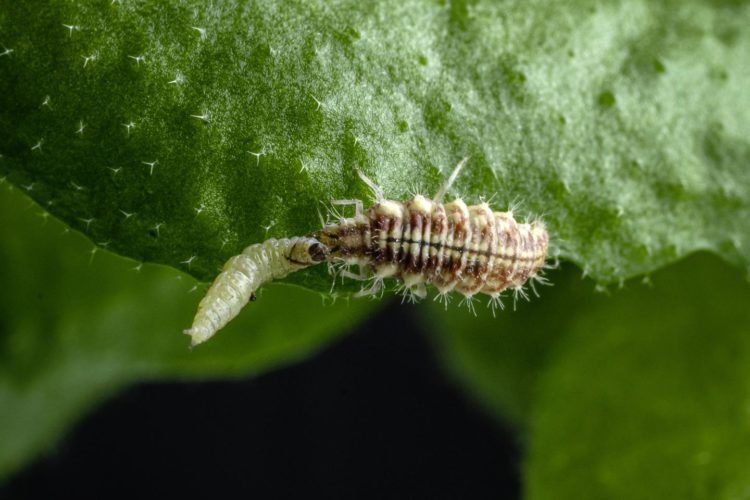Lacewing larvae are able to detoxify plant toxins too, but in a different manner as their prey: Caterpillars of the diamondback moth

Credit: Anna Schroll
Chemical defenses of plants not only affect the growth and development of herbivores, but also, indirectly, the next consumers in the food chain. A new study shows that herbivores and their predators have evolved efficient strategies to deal with toxic plant secondary metabolites. Caterpillars of the diamondback moth deploy a specific gut enzyme to render the toxic substances of their host plant harmless. Without the activity of this enzyme, growth, survival and reproduction are impaired. Nevertheless, predatory lacewing larvae feed on poisoned caterpillars without serious negative consequences, because they have their own detoxification mechanism. (eLife, December 2019, doi:10.7554/eLife.51029).
In order to successfully feed on a plant, herbivores need to overcome the chemical substances the plant produces to defend itself. One group of these defensive compounds is the glucosinolates, which are produced by all species of cruciferous vegetables, including cabbage, broccoli and horseradish, but also by the model plant Arabidopsis thaliana. Glucosinolates are easily converted into toxic isothiocyanates. Some herbivores deploy mechanisms to prevent the formation of isothiocyanates. Among them is the diamondback moth Plutella xylostella, a major agricultural pest that specializes on cabbage and related plant species. Repeated mass outbreaks have made this herbivore an economically important pest of vegetables worldwide.
A group of scientists from the Department of Biochemistry at the Max Planck Institute for Chemical Ecology in Jena, Germany, and the Indian Institute of Science Education and Research in Pune, India, wanted to find out whether the enzymatic transformation of glucosinolates is in fact a detoxification mechanism that is crucial for the growth, survival and reproduction of the pest insect. Moreover, the caterpillars of the diamondback moth are a part of a food chain because they are consumed by other insects, such as lacewing larvae. Lacewing larvae are voracious predators that feed on many different types of insect prey. For this reason, they are also used as beneficial organisms in biological pest control. The scientists therefore wanted to know how glucosinolates in herbivores would affect their predators.
First, the researchers showed that diamondback moth larvae that feed on cruciferous plants produce more of a specific detoxification enzyme. However, larvae that were no longer able to produce the enzyme were clearly impaired in their development when they were feeding on plants that produced glucosinolates in their leaves: Their growth was decreased, their survival rate was lower and they had fewer off-spring. Chemical analysis revealed that these caterpillars contained high amounts of poisonous isothiocyanates.
For the scientists, this discovery proved that enzymatic detoxification is crucial for the survival of the diamondback moth. However, Daniel Giddings Vassão, group leader in the Department of Biochemistry who led the study with Sagar Pandit from the partner institute in Pune, also points out that the formation of the enzyme is costly for the insects: “Although the presence of the enzyme significantly increases the caterpillars’ performance, this benefit comes with costs. Insects perform much better on plants without any glucosinolates at all. The ecology of plant defenses is very complex. Even when an herbivore has developed a clever chemical reaction to detoxify a plant defense compound, the plant may continue to produce chemical defenses as long as detoxification depletes insect resources.”
The scientists not only wanted to know how the caterpillars of the diamondback moth deal with plant defenses, but also whether plant defensive compounds affect the next level of the food chain, that is predatory insects that feed on these caterpillars. “We thought that blocking the chemical transformation of glucosinolates in diamondback moth caterpillars would have an unfavorable impact on predatory lacewings. However, to our surprise, we found that lacewings suffered almost no negative effects when fed on such caterpillars,” commented Ruo Sun, the first author of the study. Whether lacewing larvae feed on caterpillars that can detoxify glucosinolates or on caterpillars that contain highly toxic isothiocyanates, makes hardly any difference: Lacewing larvae grow a little more slowly when feeding entirely on poisonous caterpillars; however, this does not have any impact on their fitness and does not change their choice of prey. Further investigations revealed that lacewing larvae are also able to render isothiocyanates harmless, although they deploy a different detoxification mechanism than the larvae of the diamondback moth.
The results are also of interest with regards to possible strategies to fight this economically important pest, according to Jonathan Gershenzon, director of the Department of Biochemistry: “Our study shows that the ability of the diamondback moth to survive and develop successfully on glucosinolate-containing plants depends on its ability to chemically metabolize these defenses. Meanwhile, the common green lacewing, a generalist predator of the diamondback moth also metabolizes glucosinolates, but in a different manner. Future efforts to control the diamondback moth might therefore employ an integrated pest control strategy: interfering with diamondback moth detoxification while at the same time deploying predators, such as lacewings, that are not affected even if the herbivore lacks a detoxification system.”
###
Original Publication:
Sun, R., Jiang, X., Reichelt, M., Gershenzon, J., Pandit, S. S., Giddings Vassão, D. (2019). Tritrophic metabolism of plant chemical defenses and its effects on herbivore and predator performance. eLife. doi:10.7554/eLife.51029.
https:/
Further Information:
Dr. Daniel Giddings Vassão, Max Planck Institute for Chemical Ecology, Hans-Knöll-Straße 8, 07745 Jena. Tel. +49 3641 57-1333, E-Mail [email protected]
Prof. Dr. Jonathan Gershenzon, Max Planck Institute for Chemical Ecology, Hans-Knöll-Straße 8, 07745 Jena. Tel. +49 3641 57-1300, E-Mail [email protected]
Contact and Picture Requests:
Angela Overmeyer M.A., Max Planck Institute for Chemical Ecology, Hans-Knöll-Str. 8, 07743 Jena, Germany, Tel. +49 3641 57-2110, E-Mail [email protected]
Download of high-resolution images via http://www.
Media Contact
Dr. Daniel Giddings Vassão
[email protected]
49-364-157-1333
Original Source
http://www.
Related Journal Article
http://dx.





